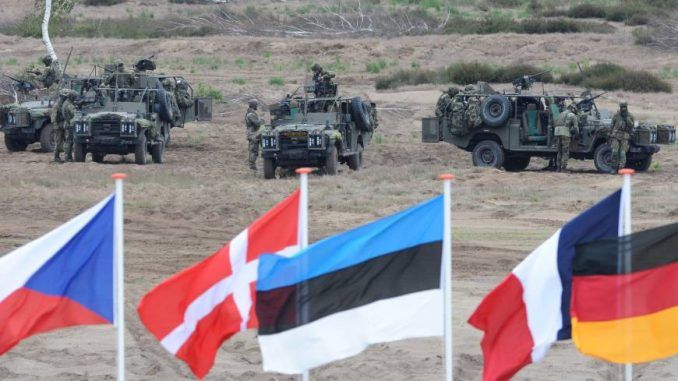
NATO have announced plans to build-up its biggest military presence on the Russian border since the Cold War, in an effort to deter Russia from invading surrounding countries.
As relations between Russia and NATO-backed allies continue to deteriorate, NATO have decided to bolster defenses on its eastern flank by stationing 40,000 troops permanently at Russia’s doorstep.
Japantimes.co.jp reports:

BYPASS THE CENSORS
Sign up to get unfiltered news delivered straight to your inbox.
You can unsubscribe any time. By subscribing you agree to our Terms of Use
NATO defense ministers will this week begin outlining plans for a complex web of small eastern outposts and warehoused equipment ready for a rapid response force, with troops on rotation and war games held regularly. The rapid response force includes air, maritime and special operations units of up to 40,000 personnel.
The allies are also expected to offer Moscow a renewed dialogue in the NATO-Russia Council, which has not met since 2014, about improved military transparency to avoid surprise events and misunderstandings, a senior NATO diplomat said.
U.S. plans for a four-fold increase in military spending in Europe, to $3.4 billion in 2017, are central to the strategy, which has been shaped in response to Russia’s annexation of Crimea from Ukraine in 2014.
NATO Secretary General Jens Stoltenberg says the U.S. plans will mean “more troops in the eastern part of the alliance . . . the pre-positioning of equipment, tanks, armored vehicles . . . more exercises and more investment in infrastructure.”
Such moves will reinforce the message from U.S. President Barack Obama, delivered in a speech in Estonia in 2014, that NATO will help ensure the independence of the three Baltic states, which for decades were part of the Soviet Union.
Lithuanian Defense Minister Juozas Olekas openly described Russia as a threat in comments to Reuters last June, but many European countries in the North Atlantic Treaty Organization are wary of upsetting the continent’s biggest energy supplier.
With such concerns paramount, diplomats and officials say NATO will not back requests for permanent bases by Poland, which has a history of fraught relations with Russia.
“I am a great proponent of strong deterrents and to improve our resilience, but I do think that the best way to do it is to do it on a rotational basis,” said Dutch Defense Minister Jeanine Hennis-Plasschaert.
Stoltenberg has also said he will not be “dragged into an arms race.”
Russia has made clear it would regard any moves to bring NATO infrastructure closer to its borders as a threat, and the Kremlin has warned that it would take “reciprocal steps.”
Western powers’ relations with Russia have deteriorated over the almost 2-year-old conflict in Ukraine, but the West also need Russia’s help in dealing with terrorism and the battle against the Islamic State group in Syria and Iraq.
If approved by Congress, Washington says one U.S. armored brigade combat team’s vehicles and equipment will be stored in warehouses in Germany and in the east, from Bulgaria to Estonia.
Moving equipment nearer a potential front is seen as crucial to be able to quickly combat surface-to-air and anti-ship missiles from Russia’s Kaliningrad exclave between Poland and Lithuania on the Baltic Sea, which could prevent forces from entering or moving across air, land and sea.
A study by the RAND Corp., a U.S. defense think tank, found that Russia could overrun the Baltic states of Estonia, Latvia and Lithuania within three days, leaving NATO and the United States no good options to respond.
Avoiding a return to the Cold War, when 300,000 U.S. service personnel were stationed in Europe, NATO generals want to adhere to a 1997 agreement with Moscow not to station substantial combat forces on the NATO-Russia border. They describe the build-up as a “persistent” but not “permanent” presence.
Some diplomats say NATO’s plans recall allied support for West Berlin in the 1950s, when British, French and U.S. forces ensured the Soviet Union could not control all of Berlin, although this time many more countries would rotate through.
“You will have small contingents in the east as a symbolic presence. It means you are not just attacking Estonia, but Britain, France or the United States,” said one NATO diplomat.
That drives home the commitment enshrined in NATO’s founding treaty that an attack on one ally is an attack on all, meaning all 28 NATO nations would be required to respond in the case of any potential Russian aggression.
Details of the plan are far from finalized, and the defense ministers meeting this week in Brussels will seek political agreement among all allies before mapping out the strategy. Issues such as how NATO nuclear weapons in Western Europe could play into any potential conflict are extremely sensitive.
Allies say there will not be permanent NATO bases in Poland or the Baltics despite strong campaigning by the new conservative Polish government. Warsaw will host the next summit of NATO leaders in July and sees offers of British and French troops for exercises as signaling a permanent presence, though diplomats deny this is the case.
“There will not be another Ramstein in Poland,” said one NATO diplomat, referring to a large U.S. Air Force base in southwestern Germany.
Poland will, however, be expected to host NATO allies at its bases temporarily and share some costs.


Russia will attack Turkey and then Israel…
Always be a light that is .shininginthedark.
Russia will attack Turkey and then Israel…
Always be a light that is .shininginthedark.
NATO-is corrupt to the bone. It needs abolished now.
NATO-is corrupt to the bone. It needs abolished now.